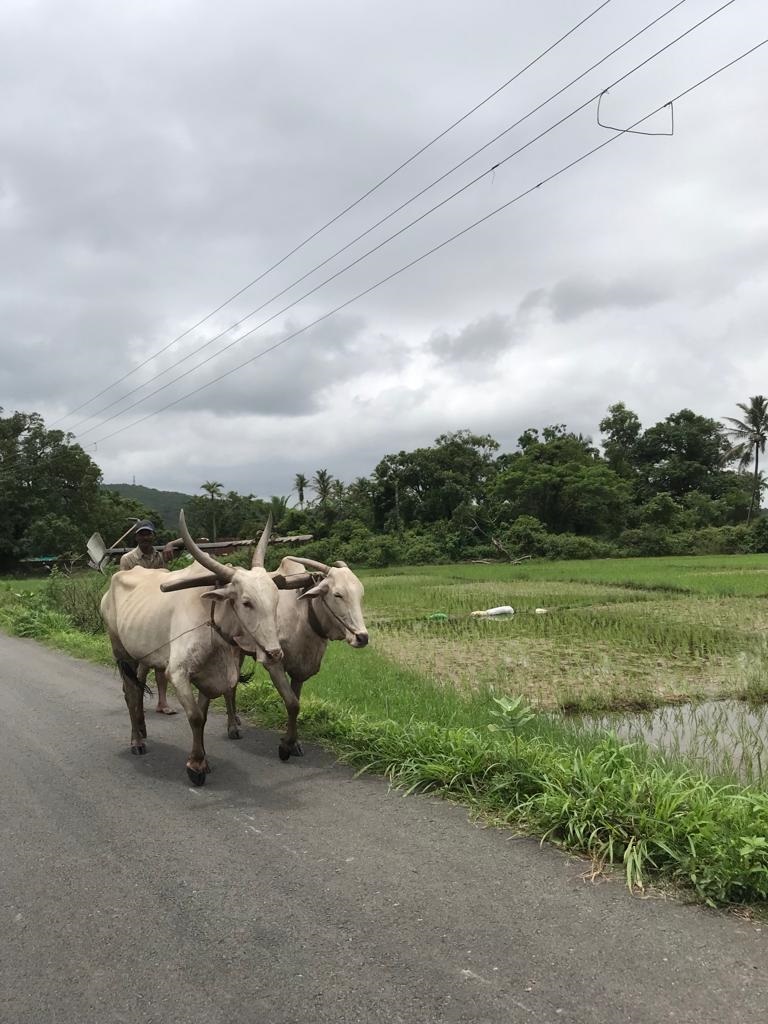
After completing the process of provisioning, the village elders would eagerly wait for the arrival of rain, which would magically make an appearance with full fury. The earth would be soaked with water and a green carpet would emerge. It was time to grow vegetables and flowering plants in the backyard and paddy in the fields.
The farmers would gear up with their ploughs and the bulls- the ploughing activities would start at predawn and would wind up till noon. In between they would get an energy booster of rice porridge called 'pez', which was served either with pickled mangoes or salted fish with a topping of coconut oil.
The 'Communidade' would ensure that community farming with an iron hold and the quality of agricultural activity and local affairs, based on principles of collective ownership and responsibilities was at its best.
The tranquillity of the sea would transform into a boisterous, tumultuous sound during the rains. The local fishermen would unwind fishing activities for three months shifting the nets and boats on shore for maintenance and the fishermen would laze around, allowing the marine lives to rejuvenate and multiply.
The seawater would invade right up to high tide level and would form small lagoons. The majestic sand dunes would act as a strong fortress against the vagaries of monsoons and preserve the fertility of cultivable land against the constant threats of salinity.
These lagoons would function as fundamental habitats for the conservation of several species that use lagoons for fish breeding as the salinity would be favourable for fish breeding. As the rainfall would reach its peak, the fresh waters from land would force open these lagoons into the sea with a variety of fish bred.
This place was locally called 'Katrololi Haddi'.
Nature rejuvenates itself. The soil erosion takes place for two months and in August the soil will be brought back on shore after nature does a wonderful job of cleansing and filtering. The beach will be back to normal- full of silver-white sand.
The landlords after their last plucking in May would lounge in their palatial houses. The vast coconut orchards would be untouched during monsoons with a booster of natural fertiliser in August.
The edible mushrooms would herald the arrival of rain and these mushrooms were prepared with hot spices and grated coconut. The house elders would have feni with fried sausages and the glow-worms would display the lights in the Balcao. One would hear the frogs croaking in the closeby lake 'tolle'. It was a time for mating and multiplying. The houses in those days had huge home gardens (Porush). All the vegetable requirements including turmeric were met by these home gardens. The most commonly grown were Snake Gourd, Bitter Gourd, Ridge Gourd, Cluster beans, Ladyfingers, Tendla, Pumpkins etc. The drumstick trees would flower and give us long juicy drumsticks. By the side of the garden, used to be a pigsty where pigs were reared as a home industry. Female pigling known as 'leitao' was mostly feasted upon on June 13 (Feast of St Anthony) and June 24 (Feast of St John the Baptist). There were numerous feasts and festivals.
The auspicious month of Shravan would be followed by Ganesh Chaturthi, which was celebrated by our Hindu brethren. The best dishes for Ganesh festival were Channa (gram) ross. Puri bhaji was superb and mouth-watering.
The River Sal was overflowing with swaying palm trees and at the back lay the majestic hills of Verna. The whole atmosphere would arouse happy hormones and the endorphin levels among villagers would hit the ceiling. Few boys would be content with fishing at the 'sankol' with a catch of local fish 'Kher' (silverfish) and 'tigur' (catfish).
The local 'Taverna' would be the only happening place for the villagers to raise their dampened spirits in the rains.
With the glasses clinking and a locally made pork dish with fine ground masala and a Torrad 'Pao' at the side, all cooked just like Grandma's style. They enjoyed it overlooking green fields. The tile houses at the edge of the paddy fields were emitting smoke and the aroma of fried Mackerel 'Para' and homemade sausages was in the moist air hitting the nostrils thus triggering and activating taste buds. The Verna hills were partially hidden by monsoon clouds. There would always be a rainbow lining which seems to be meeting at the end of the hill or the horizon of the sea.